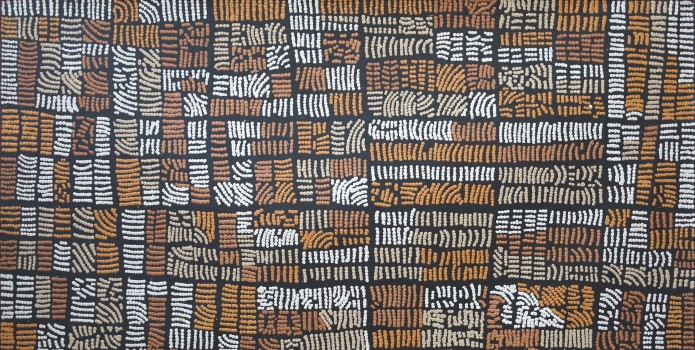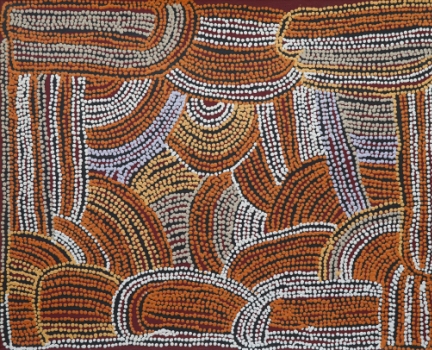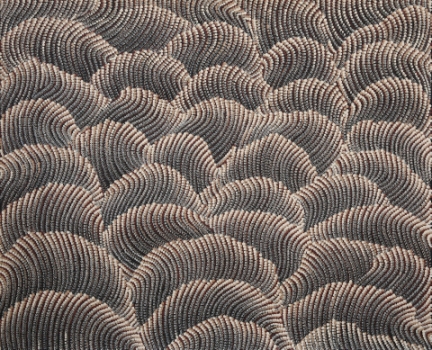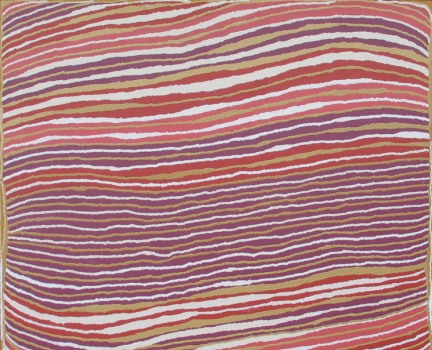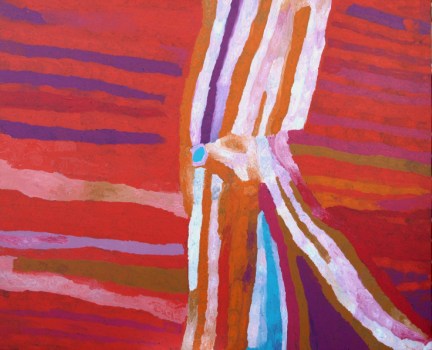Sandhills Dreaming Tali
The sandhill country that dominates much of inland Australia features widely amongst Aboriginal artists painting their desert homelands. While much of the semi- arid country of desert regions is covered in low scrub and grasslands, usually the dominating feature of the landscape is found in the patterns of the sandhills that creates the terrain.
Called Tali through much of Central Australia, desert sandhills are formed from the action of wind. Often the sandhills are set in parallel rows according to the direction of prevailing winds. The valleys between the sandhills can create their own micro-climate, and depending on the fertility of the soils and amount of water run-off, some valleys are very productive while others can be quite barren.
Knowledge about the layout of sandhills on Aboriginal clan country is a vital part of understanding this country. The sandhills can be anywhere between three and seven metres in height, so usually it is difficult to see any country beyond the next sandhill. Older Aboriginal artists who have walked their country know the terrain well. Hidden within the labyrinth of sandhills are rockholes and soakages, the critical sources of water from underground sources.
Knowledge of the sandhills and the plants that grow around them is also important in locating the best areas for bushtucker. Traditionally nomadic people return to set locations when the season is right to collect seeds, fruit, berries and nuts. Returning to the locations requires accurate knowledge of the country.
Different artists find and represent the sandhill patterns of their home country in distinctive ways. Lily Kelly Napangardi from Mt Liebig and Maureen Nampijinpa Hudson from Mt Allan depict the sandhills with fine rows of ever diminishing dots. Their art suggests the grainy and ephemeral nature of desert sand dunes, with repeated patterns showing the vast distance.
Tjawina Porter Nampitjinpa from Docker River and Lorna Ward Napanangka from Kintore paint recurring patterns of sandhills to show country built up from modules. The variety of the structures and the random patterns build up a map of country, into which the artist places important elements from their spiritual connection with the land.
Eileen Napaltjarri from Kintore creates strong bands of colour representing the sandhill formations then marks in the significant waterhole sites for that country. Kimberley artists Jimmy Pike and Biddee Baadjo use the powerful patterns of sandhills to frame their works and identify the country where the story originates. Similarly, Linda Syddick Napaltjarri from Kintore gives the narrative of a Tingari story, or a family event, and surrounds it with the patterns of the sandhills of that region.
These visions of country are conceived from an aerial perspective, even though the artists experience their country from the ground up. Within that perspective the paintings might include the forces of the environment at work, with the effects of wind and water on this desert landscape.
View Artists:
- Lily Kelly Napangardi
- Maureen Nampijinpa Hudson
- Eileen Napaltjarri
- Linda Syddick Napaltjarri
- Eubena Nampitjin
- Biddee Baadjo
- Jimmy Pike
- Anna Petryare
- Kim West Napurrula
- Lorna Ward Napanangka
- Tjawina Porter Nampitjinpa
- Wentja Napaltjarri
Back to Aboriginal Dreamtime Stories

